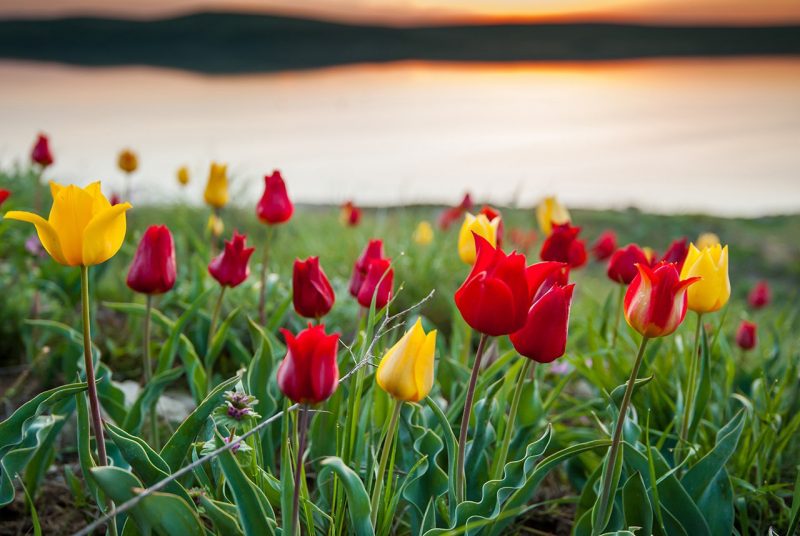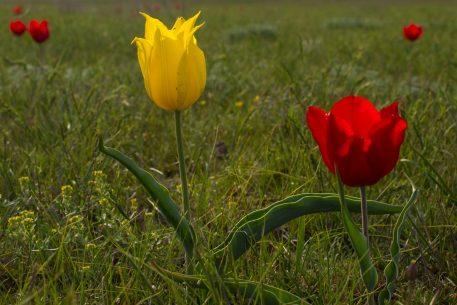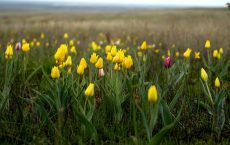A beautiful wild plant in spring blooms endless steppes and dull semi-deserts with bright strokes, mostly red and yellow. The modern Schrenk tulip is not introduced into the culture, although its distant descendants adorn the flower beds. The species got on the pages of the Red Book, because in the nature of these plants are critically few.
Material Content:
History of Schrenk tulip varieties
The species belongs to the genus Tulip, the Liliaceae family. Tulip is an ephemeroid, like many other flowering herbaceous perennials in the steppes and semi-deserts. Plants bloom quickly in the spring when there is enough moisture, and the sun is not so merciless. The tulip spends the rest of the year in the ground, in the form of a bulb. Other typical ephemeroids are small jugs, crocuses, anemones, and bluebells.
Schrenk's tulip received the botanical name in honor of the Russian biologist and geologist. A. Schrenk traveled extensively in the regions of Russia, described nature, and collected collections for the university and the Botanical Garden. A new type of tulip was discovered in the steppes in southern Siberia. The botanist and gardener E. Regel described it.
The history of the flower, known as Schrenk's tulip, is closely connected with the oldest group of varieties - Duke van Toll. These are miniature plants blooming in early spring. Schrenka's tulip is considered the ancestor of the varietal group, which is not the most popular today, but has many fans. The flowers may have a red-yellow, pink, yellow or purple color. Varieties with white, orange, lilac-pink and striped petals are bred.
View description
A modified plant shoot is deep in the ground. This is an onion-shaped bulb with a diameter of up to 3 cm. The scales are dark, leathery. For the entire time of life, the mother’s bulb of Schrenk’s tulip forms one baby.

The dark green stalk with reddish veins has a length of up to 40 cm. At the base there are 3-4 greenish-gray leaves 20 cm long, with wavy edges. They do not grow above the peduncle, can lie down.
Usually, in the description of Schrenk's tulip, special attention is paid to the flower. At first it has a cupped shape, later - lilac. The flower consists of 6 rather large petals with a length of 7–8 cm. The diameter is 5–6 cm. The color of the petals and aroma vary depending on the place of growth. Schrenk's tulips with yellow and red flowers, lighter at the base, are more common. Stamens and anthers are yellow and purple.
Flowering and propagation
The time of leaves and flower arrows coming out of the soil depends on the local climate and weather conditions. In the main areas where the species grows, flowering occurs in April, early May. If there is enough moisture, then tulips bloom en masse under natural conditions. One flower is stored on the stem for 1-2 weeks. In an arid spring, tulips do not throw out a flower arrow, "wait" for bad weather in the soil.

The fruit of the tulip is an elongated box with three wings. There are many seeds inside, up to 250 pieces. After drying, the fruit bursts, the seeds spill out onto the soil, and some are picked up by the wind and spread to new habitats.
In the first year, a small bulb with one cotyledon leaf develops from the seed. A young plant is buried every year in the soil. Real leaves appear - 1 or 2 pieces. The bulb accumulates more and more nutrients. Only after 6 or 7 years does the vegetation cycle become complete. Real leaves and peduncle grow, a bud forms and blooms, seeds ripen. The old bulb dies at the end of the growing season, one baby remains in its place.
In the development cycle, the main difference between Schrenk tulip and modern varieties is manifested - a single flowering during life (6–7 years).
Garden tulips bloom profusely every year. They dig up the bulbs and create a period of rest for them. If you do not dig, then the plant will bloom stably for 3-4 years in a row, then the bulb degenerates.
Places of distribution
In the wild, Schrenka tulip still grows in forest steppes, foothills, steppes in the north of Kazakhstan, the south and southeast of Russia, Ukraine. The flower is found in Iran and China.
Read also:Cyclomania flower: care and reproduction
The plant is a calcephilic, prefers soils with a high content of calcium. Schrenk's tulip can be found near Cretaceous deposits and solonchaks in semi-deserts. This species is not afraid of frosts and snowy winters.
Why is the flower listed in the Red Book?
It is strictly forbidden to pick these flowers, dig bulbs in the natural habitat of Schrenk's tulip. The species is threatened with extinction, so it is listed in the Red Book.
The reasons are the features of the vegetation cycle, as well as the economic activities of people - land development, plowing the steppes, construction, grazing.
Is it possible to grow Schrenk's tulip at home?
If you have enough patience, perseverance and dexterity, then the seeds of a wild-growing tulip can be sown in the garden. But there is very little chance that the soil and microclimate will do. Under favorable conditions, the seed will germinate. Flowering will have to wait for a long 6 or 7 years. There are many modern varieties that are not inferior in beauty, or surpass Schrenka tulip by this criterion.
Preserving the natural look in this way is impractical. Many varieties and hybrids can be grown in the garden and flower beds. Schrenka's tulip is better preserved when organizing nature reserves and wildlife sanctuaries in countries where this ancient flowering plant is still found.


















